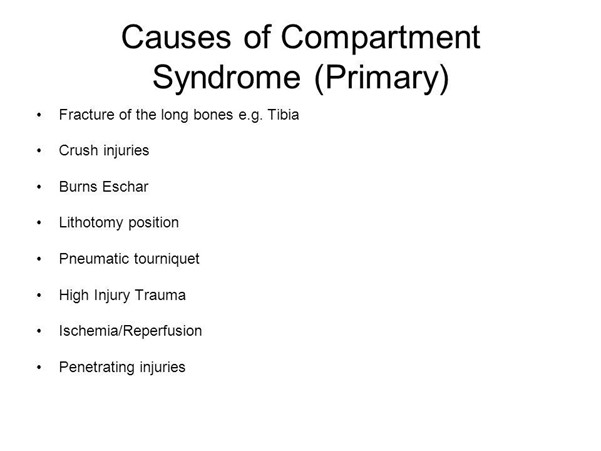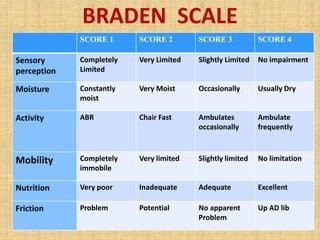The nurse is caring for a client who is diagnosed with an arterial insufficiency ulcer. The nurse should plan interventions to address which priority issue?
Chronic pain
Impaired skin integrity
Risk for injury
Ineffective tissue perfusion
The Correct Answer is D
A. Chronic pain - Chronic pain is a concern for the client, but addressing the underlying issue of ineffective tissue perfusion will help alleviate pain by promoting healing and reducing tissue damage.
B. Impaired skin integrity - Impaired skin integrity is a result of ineffective tissue perfusion. By addressing perfusion issues, skin integrity can be improved as tissues receive adequate oxygen and nutrients for healing.
C. Risk for injury - While clients with arterial insufficiency ulcers are at risk for injury, the immediate concern is addressing the ineffective tissue perfusion to prevent complications related to poor circulation, such as tissue necrosis and infection.
D. Ineffective tissue perfusion- Arterial insufficiency ulcers are caused by inadequate blood flow to the tissues. The priority issue for a client with an arterial insufficiency ulcer is ineffective tissue perfusion. Due to decreased blood flow, tissues do not receive enough oxygen and nutrients, leading to delayed wound healing, tissue damage, and potential complications. Interventions should focus on improving circulation, promoting vasodilation, and enhancing perfusion to facilitate wound healing and prevent further tissue damage.
Nursing Test Bank
Naxlex Comprehensive Predictor Exams
Related Questions
Correct Answer is C
Explanation
A. Malignant hypothermia: This is a rare but life-threatening reaction to certain medications used during anesthesia. It doesn't typically manifest with calf edema.
B. Pulmonary embolism: While pulmonary embolism can occur as a complication in some cases, it is characterized by symptoms like sudden shortness of breath, chest pain, and may not directly cause calf edema.
C. Acute compartment syndrome
Increasing edema in the calf of a client with multiple fractures of the leg is a manifestation of acute compartment syndrome. Acute compartment syndrome occurs when there is increased pressure within a muscle compartment, which can lead to reduced blood flow, nerve damage, and tissue hypoxia. The edema and increased pressure can compress blood vessels, nerves, and muscle tissue within the compartment, resulting in symptoms such as severe pain, edema, and potential vascular compromise.
D. Fat embolism syndrome: This syndrome can occur in clients with long bone fractures, but it is characterized by respiratory and neurologic symptoms, not isolated calf edema.

Correct Answer is B
Explanation
A. Morse Scale:
The Morse Scale, also known as the Morse Fall Scale, is used to assess a patient's risk of falling. It evaluates various factors such as history of falling, secondary diagnosis, ambulatory aids, IV therapy, gait, and mental status. It is primarily focused on assessing the risk of falls, not pressure ulcers.
B. Braden Scale:
As previously mentioned, the Braden Scale assesses a patient's risk for developing pressure ulcers. It takes into account sensory perception, moisture, activity, mobility, nutrition, and friction/shear. The scale helps healthcare providers determine the level of risk a patient has for developing pressure sores and guides interventions to prevent them.
C. Bristol Scale:
The Bristol Stool Scale is used to classify the form of human feces into seven categories. It is a medical aid designed to classify the form of human feces into seven categories. This scale is primarily used to assess bowel movements and is unrelated to pressure ulcers.
D. Hendrich II Scale:
The Hendrich II Fall Risk Model is a tool designed to identify patients at risk for falls. It includes factors such as confusion, symptomatic depression, altered elimination, dizziness, male gender, and the use of antiepileptics, benzodiazepines, or non-opioid analgesics. Similar to the Morse Scale, it focuses on assessing the risk of falls, not pressure ulcers.

Whether you are a student looking to ace your exams or a practicing nurse seeking to enhance your expertise , our nursing education contents will empower you with the confidence and competence to make a difference in the lives of patients and become a respected leader in the healthcare field.
Visit Naxlex, invest in your future and unlock endless possibilities with our unparalleled nursing education contents today
Report Wrong Answer on the Current Question
Do you disagree with the answer? If yes, what is your expected answer? Explain.
Kindly be descriptive with the issue you are facing.
